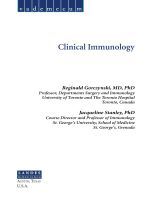The primary purposes of this book are first, to introduce the reader to the fundamental components of the immune system and the basic concepts involved in understanding how those components interact to achieve host defense, and second to highlight how that understanding proves invaluable to diagnosis and treatment of a wide variety of clinical disorders. In the introductory chapters attention is focused on the cells and factors which make up both the innate and acquired immune systems. While the innate system is often thought of as the "primitive" immune system, we will see that it is in many ways no less complex and wide- ranging, in its action than the acquired (adaptive) system. The acquired immune system is, itself, composed of a unique collection of specialized cells (lymphocytes) which have the remarkable capacity to undergo genomic DNA rearrange¬ments to generate populations with a seemingly infinite capacity to recognize foreign (non-self) molecular determinants. As might be expected, development of such diversity necessarily brings with it the concomitant need to ensure that the self is still recognized as such (and thus protected from whatever host defense mechanisms are brought to bear upon "foreign", non-self, material (or organisms). Understanding how self:nonself discrimination occurs naturally, how and why it sometimes fails, and how it may be controlled exogenously, remain some of the key problems in contemporary immunology and clinical immunology
Section I: Essential Immunobiological Concepts in Clinical Immunology. 1
1 An Introduction: The Immune System. 2
Objectives. 2
The Immune System. 3
General Features. 3
Innate Immune Responses 4
Adaptive Immune Responses. 6
Cells That Function in Innate Immune Responses. 8
Cells That Function in Adaptive Immune Responses. 11
Tissues of the Immune System: General Features. 12
Tissues of the Immune System: Primary Lymphoid Organs. 12
Tissues of the Immune System: Secondary Lymphoid Tissues. 14
Soluble Mediators of the Immune System. 20
Molecules That Activate Lymphocytes. 22
Molecules That Activate Lymphocytes: Monoclonal Activators. 22
Molecules That Activate Lymphocytes: Oligoclonal Activators. 24
Molecules That Activate Lymphocytes: Polyclonal Activators. 24
Summary. 25
Clinical Cases and Discussion. 26
Test Yourself. 29
2 Innate Immune Responses to Pathogens. 31
Objectives. 31
Innate Immune Responses to Pathogens. 32
General Features. 32
Role of Complement. 32
Phagocytosis. 32
Genetic Defects in NADPH Oxidase: Chronic Granulomatous Disease. 42
Natural Killer Cells. 42
Eosinophils. 45
Summary. 45
Clinical Cases and Discussion. 46
Test Yourself. 49
3 Antigen Presenting Cells. 51
Objectives. 51
Antigen Presenting Cells. 51
Antigen Presenting Molecule: General Features. 55
Antigen Presenting Molecule: Class I MHC Molecules. 56
Antigen Presenting Molecules: Class II MHC Molecules. 61
Antigen Presenting Molecules: CD1 Molecules. 64
Summary. 64
Clinical Cases and Discussion. 65
Test Yourself. 67
4 Soluble Mediators of Immunity I: Antibodies. 69
Objectives. 69
Antibodie. 69
General Features of Antibodies. 69
Structure Function Relationship of Antibodies. 71
Properties of Immunoglobulin Isotypes. 72
Monoclonal Antibodies. 77
Monoclonal Antibodies as Therapeutic Agents. 78
Clinical Trials. 79
Summary. 80
Clinical Cases and Discussion. 81
Test Yourself. 84
5 Soluble Mediators of Immunity II: Complement. 85
Objectives. 85
Complement. 86
Complement Pathways: General Features. 86
Complement Biological Activities. 93
Complement Regulation. 95
Complement and Coagulation Pathways Are Linked via Kallikrein 99
Complement Genetic Deficiencies 99
Role of Complement in Medicine. 103
Xenotransplantation: Complement Is Deleterious. 103
Summary. 104
Clinical Cases and Discussion. 105
Test Yourself. 108
6 Soluble Mediators of Immunity III: Cytokines. 110
Objectives. 110
Cytokines. 111
General Features. 111
Cytokine Receptors That Engage the JAK/STAT Pathway. 111
Cytokine Receptors That Engage SMADs. 117
Biological Activities of Cytokines That Signal via the JAK/STAT Pathway. 117
Clinical Relevance of Cytokines. 120
Chemokines. 124
Summary. 125
Clinical Cases and Discussion. 125
Test Yourself. 128
7 Cells of Adaptive Immunity. 130
Objectives. 130
B-lymphocyte Antigen-specific Receptor. 130
Constructing an Immunoglobulin. 131
B-cell Differentiation: Bone Marrow. 134
Clinical Significance: B-cell Neoplasms. 137
Summary. 137
T-lymphocyte Antigen-specific Receptor. 137
Differentiation of Lymphoid Progenitor Cells in the Thymus. 140
Transport of Lymphocytes from Primary to Secondary Lymphoid Tissues. 146
Summary. 146
Clinical Cases and Discussion. 147
Test Yourself. 152
Antigen Dependent B-cell Differentiation. 153
Objectives. 153
8 Antigen Dependent B-cell Differentiation. 153
Fate of Activated В Cells in Germinal Centers. 155
Primary versus Secondary Immune Responses. 159
Clinical Significance. 159
Models of Signal Transduction in B-cell Activation. 160
Negative Signaling in В Cells. 161
B-cell Responses to T-independent Antigens. 163
Summary. 164
Clinical Cases and Discussion. 164
Test Yourself. 166
9 T Lymphocytes. 168
Objectives. 168
CD4+ T cells: Antigen Induced Differentiation. 168
Memory CD4+ T Cells. 174
Clinical Relevance of Type 1 versus Type 2 Cytokines. 175
CD8+ T Cells: Antigen Induced Differentiation. 177
Memory CD8+ T Cells. 179
Clinical Relevance CD8+ T Cells. 179
Model of Signal Transduction in T-cell Activation. 180
Negative Regulation of T-cell Signaling. 182
Memory Lymphocytes in Immunosurveillance. 182
Gamma/Delta T Cells. 184
Summary. 185
Clinical Cases and Discussion. 186
Test Yourself. 189
10 Inflammation. 190
Objectives. 190
Inflammation. 191
General Features. 191
Vasodilatation, Increased Vascular Permeability and Edema. 191
Recruitment of Neutrophils and Monocytes to the Site of Inflammation. 195
Adaptive Immune Responses in Inflammation. 202
Role of Innate and Adaptive Immunity in Inflammation. 203
Clinical Relevance. 204
Summary. 204
Clinical Cases and Discussion. 205
Test Yourself. 209
11 Immunological Responses to Microbes. 211
Objectives. 211
Immunity to Microbes. 212
General Features. 212
Host Defenses to Extracellular Bacteria. 212
Resistance to Immunity: Extracellular Bacteria. 217
Host Defenses to Viruses. 217
Resistance to Immunity: HIV. 222
Host Defenses to Intracellular Bacteria. 224
Resistance to Immunity: Intracellular Bacteria. 226
Host Defenses to Fungi. 227
Resistance to Immunity: Fungi. 229
Summary. 230
Clinical Cases and Discussion. 232
Test Yourself. 236
12 Section II: Clinical Immunology in Practice. 239
Immunization. 240
Objectives. 240
Immunization. 241
Passive Immunization. 242
Active Immunization or "Vaccination". 244
Forms of Vaccines. 247
Vaccine Efficacy and Safety. 254
Successful Application of Vaccine Technology. 255
Limited Use Vaccines and Experimental Vaccines. 256
Uses of Vaccines (for Other than Control of Infection). 258
Summary. 258
Clinical Cases and Discussion. 259
Test Yourself. 264
13 Hypersensitivity Reactions. 266
Objectives. 266
Hypersensitivity Reactions. 267
General Features. 267
Type I: Immediate Hypersensitivity Reactions. 267
Type II: Antibody-mediated Hypersensitivity Reactions. 272
Type III: Immune-complex Mediated Hypersensitivity. 276
Type IV: Cell-mediated Hypersensitivity. 278
Summary. 282
Clinical Cases and Discussion. 283
Test Yourself. 287
14 Autoimmunity. 289
Objectives. 289
Autoimmunity. 290
General Features. 290
Tolerance Induction. 290
Loss of Self Tolerance. 293
Immunopathology of Autoimmune Disorders: Autoreactive Antibodies. 296
Immunopathology of Autoimmune Disorders: Cell Mediated Immunity. 299
Immunotherapy of Autoimmune Disease: Suppression. 301
Immunotherapy of Autoimmune Disorders: Cytokine Modulation. 306
Summary. 307
Clinical Cases and Discussion. 308
Test Yourself. 312
15 Immunodeficiency Disorders. 314
Objectives. 314
Immunodeficiency Disorders. 315
General Features. 315
Primary Immunodeficiency Disorders. 315
Primary Immunodeficiency Disorders: Progenitor Cells. 315
Primary Immunodeficiency Disorders: T Cells. 319
Primary Immunodeficiency Disorders: В Cells. 320
Primary Immunodeficiency Disorders: Phagocytic. 323
Primary Immunodeficiency Disorders: Other Leukocytes. 323
Primary Immunodeficiency Disorders: Complement System. 323
Secondary Immunodeficiency Disorders. 327
Secondary Immunodeficiency Disorders: Acquired. 329
Secondary Immunodeficiency Disorders: Abnormal Production of Immune Components. 330
Summary. 330
Clinical Cases and Discussion. 331
Test Yourself. 335
16 Tumor Immunology. 337
Objectives. 337
Tumor Immunology. 338
General Features. 338
The Concept of Immunosurveillance. 338
Tumor Antigens. 340
Tumor Immunosurveillance. 344
Effector Mechanisms for Elimination of Tumors. 345
Evasion of Immune Surveillance. 349
Immunology in Diagnosis or in Monitoring Prognosis. 354
Novel Therapies: Enhancing Antigen Presentation by Dendritic Cells. 355
Novel Therapies: Cytokines and other Molecules Transfected into Tumor Cells Themselves. 357
Novel Therapies: Modification of CTL as a Strategy for Enhancing Tumor Immunity. 359
Novel Therapies: Monoclonal Antibodies and Immunotherapy. 359
Summary. 360
Clinical Cases and Discussion. 361
Test Yourself. 366
17 Transplantation. 367
Objectives. 367
Transplantation. 368
General Features. 368
Classification of Grafts According to Their Source. 368
Classification of Graft Rejection. 371
Genetics of Transplantation. 373
Immunology of Graft Rejection. 379
Tissue Differences in Clinical Transplantation. 387
Graft Versus Host Disease. 389
Immunosuppression in Transplantation. 389
Summary. 391
Clinical Cases and Discussion. 392
Test Yourself. 396
Index. 398

